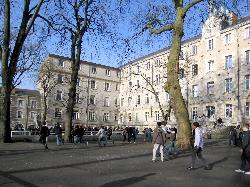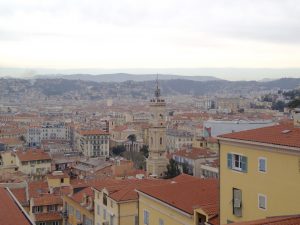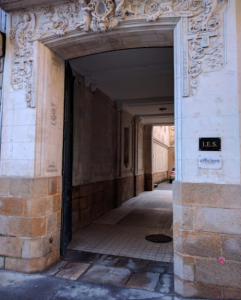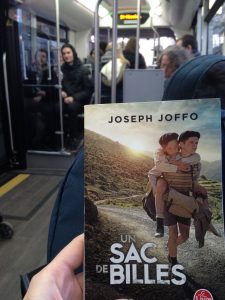The morning hadn’t quite gone as planned. Having almost missed the bus from my study abroad center, I had rushed to the school’s office, where I was told, as usual, that I needed to hand over a “pièce d’identité” (translation: ID card) in exchange for my visitor’s badge, which I eventually produced, but only after a few awkward seconds where I managed to fish out everything in my jacket pocket EXCEPT my Université de Nantes ID card (house keys, bus pass, a receipt for the dinner at the crêperie the night before (galettes are still my favorite food), a bottle of hand-sanitizer (my secret weapon- always be prepared)…).
It was the second week of my teaching internship, and my first real chance to play English teacher. By some miracle, I ended up at the classroom on time, a little breathless and with my visitor’s badge slightly askew (lanyards and scarves do not mix well). Mme Morrhonnière, as I shall call her, greeted me with a “Hello”. We had agreed the week before that I would prepare a 15-minute activity, and that she would send small groups to rotate through so everyone could have a chance to participate. Mme Morrhonnière handed me a whiteboard marker and the keys to an empty classroom upstairs, sent 10 kids with me, and that was that. I was terrifyingly free!
I found myself standing in front of a classroom with 10 pairs of eyes trained upon me, armed only with my wits and a whiteboard marker.
I decided to do the only thing I knew how to do- just take the plunge and do it.
The topic was “What did you do for vacation?” which is pretty self-explanatory. I started by explaining my own February vacation, complete with a dazzling array of hastily drawn stick figures depicting me going from Nantes to Strasbourg to Lyon to Nice, which took up so much room that I decided to move to the middle whiteboard.
It was then that I heard a suspicious giggling behind me.
“What?” I asked, instantly questioning whether it was, in fact, acceptable to write on the middle whiteboard. “Is this ok?” I asked the class. The giggles subsided. I heard a “yeah” from somewhere, and though there was still a tiny nagging doubt in my mind (maybe I wasn’t supposed to use the center whiteboard?) I just kept going, and soon I was on a roll, writing vocab words and drawing more silly pictures to make sure they understood what in the world this crazy American college student was talking about.
Some travel photos from my vacation, so at least you will have an idea of what in the world I was talking about:
Three groups later, and I was finally finished. It had been a whirlwind of an hour, the minutes whirring by faster than I thought they would. The most popular vacation activity? Sleeping, tied closely with watching T.V., which sounds about accurate for middle school. Playing video games was also a popular option.
The students left, with a mix of “Au revoir”s and “Goodbye”s, and I started to clean off the whiteboard, which went well…until I tried to erase the middle board.
The pen marks just wouldn’t erase. Frustrated, I tried wiping harder, and though it did take off some of the ink, the writing was still legible, along with my now ridiculous-looking sketches of stick-figure Megan travelling around France.
My mounting panic was interrupted by the clang of the door as the school janitor walked in. Though she most definitely saw my panicked expression, she didn’t say a word.
“Um, excuse me but this isn’t really erasing very well,” I said in a nervous jumble of French.
She gave me a long look. Then came the fatal words: “That’s because that board is the electronic board. It’s not for writing.”
Time stopped momentarily as I stared at the traitorous board in horror, imagining my stick figures and vocabulary words etched on the smart board for eternity. “I visited ______”, “I stayed home”, “mountains”, “skiing”…. I had officially joined the unfortunate legions of New-Teachers-Who-Made-The-Mistake-Of-Using-White-Board-Markers-To-Write-On-The-Smart-Board-Even-Though-Everyone-Else-Knows-That-Is-A-No-No. My face flushed, and I must have muttered some string of apologies, but I was saved by the arrival of Mme Morrhonnière, who walked in, took one look at my stricken face and the janitor’s accusing glare, and muttered “punaise!” (a French curse word that literally either means “bug” or “thumbtack”, depending on context)
Fortunately, with quick action and a lot of alcohol wipes, the smart board was saved, with only a slight tint of blue to suggest that anything had ever happened. I breathed a huge sigh of relief, eager to get back on the good side of this school.
“Well, at least now I know better for next time,” I said.
“Well, maybe next time we’ll put you in a different room,” Mme Morrhonnière suggested.
I grinned. “That would probably be a good idea.”
Luckily for me and for the middle school smart boards, I have become much more savvy about where I can write during classes. Though preparing lessons is a new challenge, my favorite part about teaching so far is interacting with the students. They never cease to surprise me. Last week, I taught a lesson about careers, and though we had the usual mix of surgeons, lawyers, chefs, race-car drivers, and CEOs, one student proudly told me that he wanted to be a dictator…if being a CEO didn’t work out, that is.










